
In its Recovery Strategy the EU Commission encouraged Member States to invest in green and future-proof technologies such as wind. With the right regulatory framework in place, wind energy promises immediate and lasting job creation to spur the EU economy. Throughout the COVID-19 pandemic, wind has proved resilient both in terms of power production from existing wind farms and installation of new turbines, as WindEurope figures show.
But government policy and regulation remain key to job creation. Take MHI Vestas, a leading manufacturer of offshore wind turbines. MHI Vestas have just announced 150 redundancies in Denmark. This follows several other job losses from turbines manufacturers around Europe this year, and these are not linked to COVID-19.
The two most important parameters for job creation are (a) government commitments to the further expansion of renewables with clear volumes and auction timetables and (b) simple rules and procedures for the permitting of new wind farms. The National Energy & Climate Plans (NECPs) are meant to deliver these. They are OK on the volumes. But they fall a long way short on permitting. And this puts jobs at risk.
“The NECPs are a big step forward for the visibility of future renewable energy projects. And most plans and auction schedules are positive. If implemented as submitted, the EU will hit 33% renewables in final energy in 2030. Now the national Governments need to get active and start translating the NECPs into concrete legislation. They need to fix and stick to the auction schedules. They need to choose the right auction design. But if Governments don’t fix permitting, they will not achieve these volumes and their ambitious targets will remain purely academic”, says Giles Dickson, WindEurope CEO.
The lesson is clear. Policy-makers must ensure a maximum of clarity on auction design and schedules in particular now during the recovery phase. Getting auctions right will set off Europe on a course of faster recovery.






